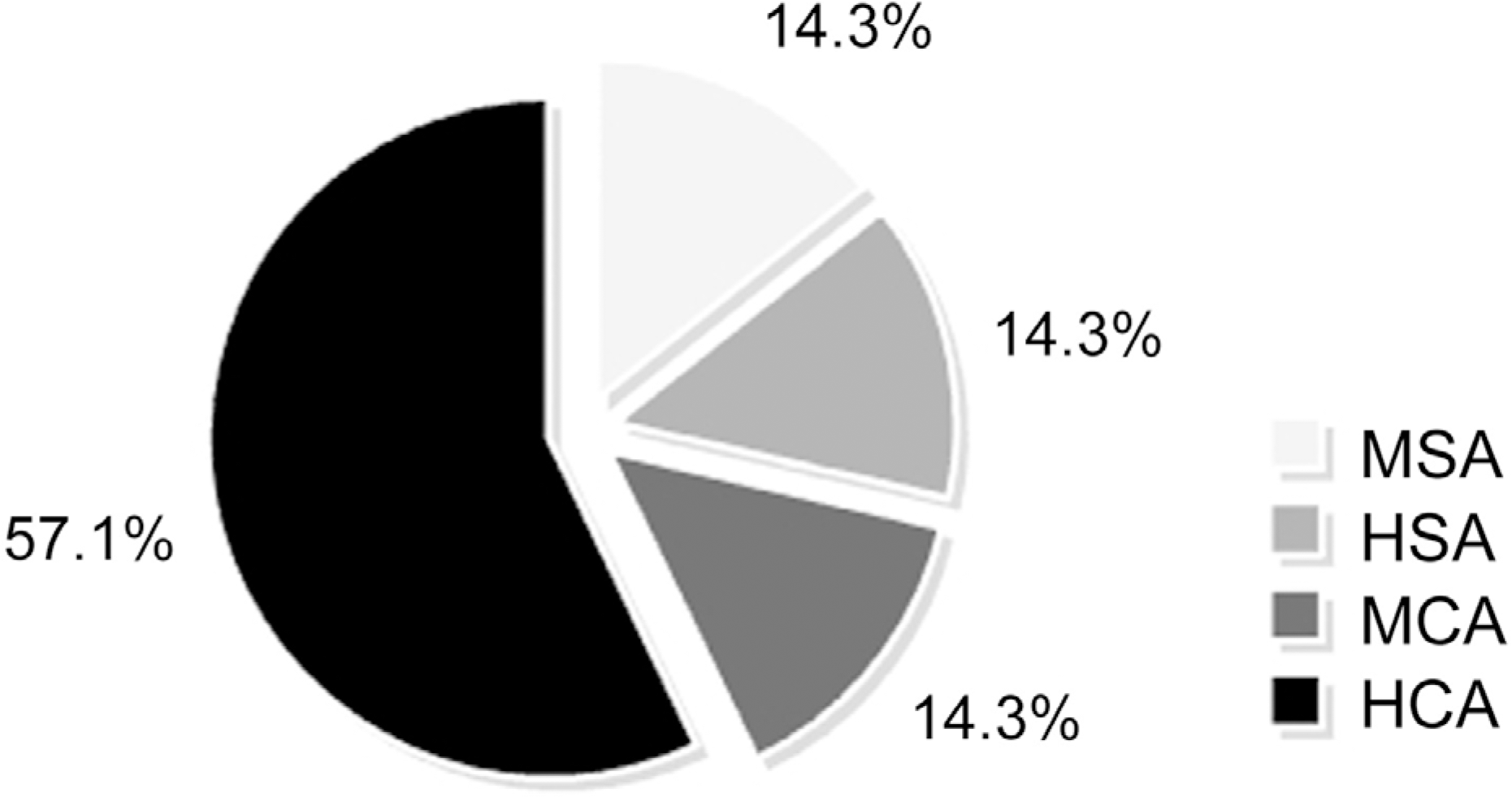Abstract
Purpose
To determine the frequency of amblyopia and anisometropia in intermittent exotropia and to evaluate the relationship between anisometropia and amblyopia.
Methods
The medical records of 471 intermittent extotropia patients, who were followed up over a period of 6 months and ranged from 3 to 15 years of age had been retrospectively reviewed. Anisometropia patients, who had either spherical or cylindrical anisometropia of more than 1.00D, were divided into 4 groups: spherical hyperopic anisometropia (SHA), spherical myopic anisometropia (SMA), cylindrical hyperopic anisometropia (CHA), and cylindrical myopic aniometropia (CMA).
Results
The frequency of amblyopia in the intermittent exotropia group was 41/471 (8.7%). Amblyopia results in a significant increase in the incidence of anisometropia and a decrease in binocular function when compared with non-amblyopic patients. In the amblyopia group, 14 patients had anisometropia (34.1%) consisting of 2 patients with spherical myopic anisometropia (SMA), 2 patients with spherical hyperopic anisometropia (SHA), 2 patients with cylindrical myopic anisometropia (CMA) and 8 patients with cylindrical hyperopic anisometropia (CHA). In the anisometropia group (n=56) 14 patients (25.0%) had amblyopia and in the non‐ anisometropia group (n= 415) 27 patients (6.5%) had amblyopia.
Go to : 
References
1. von Noorden GK. Binocular vision and ocular motility. 5th ed.St. Louis: Mosby;1996. p. 8–40.
2. Abrahamsson M, Sjostrand J. Contrast sensitivity and acuity relationship in strabismic and anisometropic amblyopia. Br J Ophthalmol. 1988; 72:44–9.

3. Simons K. Amblyopia characterization, treatment, and prophylaxis. Surv Ophthalmol. 2005; 50:123–66.

4. von Noorden GK. Amblyopia: a multidisciplinary approach. Proctor lecture. Invest Ophthalmol Vis Sci. 1985; 26:1704–16.
5. Pediatric Eye Disease Investigator Group. A randomized trial of atropine vs. patching for treatment of moderate amblyopia in children. Arch Ophthalmol. 2002; 120:268–78.
6. Pediatric Eye Disease Investigator Group. The clinical profile of moderate amblyopia in children younger than 7 years. Arch Ophthalmol. 2002; 120:281–7.
7. Rahi JS, Dezateux C. National cross sectional study of detection of congenital and infantile cataract in the United Kingdom: role of child-hood screening and surveillance. The British Congenital Cataract Interest Group. BMJ. 1999; 318:362–5.
8. Fahle M. Naso‐ temporal asymmetry of binocular inhibition. Invest Ophthalmol Vis Sci. 1987; 28:1016–7.
10. Beneish R, Flanders M. The role of stereopsis and early postoperative alignment in long‐ term surgical results of intermittent exotropia. Can J Ophthalmol. 1994; 29:119–24.
11. Smith K, Kaban TJ, Orton R. Incidence of Amblyopia in Intermittent Exotropia. American Orthoptic Journal. 1995; 45:90–6.

12. Han JH, Kim DS, Shin JC. Amblyopia and sensory fusional anomaly in intermittent exotropia. J Korean Ophthalmol Soc. 2000; 41:495–9.
14. Weakley DR Jr. The association between nonstrabismic anisometropia, amblyopia, and subnormal binocularity. Ophthalmology. 2001; 108:163–71.

16. Ikeda H, Wright MJ. Is amblyopia due to inappropriate stimulation of the “sustained” pathway during development? Br J Ophthalmol. 1974; 58:165–75.

17. Kim HY, Chang BL. Clinical evaluation of exotropia combined with amblyopia in children. J Korean Ophthalmol Soc. 1996; 37:662–8.
18. Lee SJ, Park SH, Shin H. Stereopsis in child amblyopes. J Korean Ophthalmol Soc. 1995; 36:1598–604.
19. Stathacopoulos RA, Rosenbaum AL, Zanoni D, et al. Distance stereoacuity. Assessing control in intermittent exotropia. Ophthalmology. 1993; 100:495–500.
20. Brooks SE, Johnson D, Fischer N. Anisometropia and binocularity. Ophthalmology. 1996; 103:1139–43.

21. American Academy of Ophthalmolgy. Amblyopia, Preferred Practice Pattern. San Francisco: The Academy;1997. p. 5–6.
Go to : 
 | Figure 1.Percentage of each type of anisometropia in the amblyopia patients. MSA=myopic spherical anisometropia; HAS=hyperopic spherical anisometropia; MCA=myopic cylindrical anisometropia; HCA=hyperopic cylindrical anisometropia. |
Table 1.
Clinical characteristics of amblyopia and non-amblyopia group
| Amblyopia (n=41) | Non‐amblyopia (n=430) | p-value | |
|---|---|---|---|
| Gender (Male:Female) | 21:20 | 199:231 | 0.624* |
| Age (Yr) | |||
| Diagnosis | 6.17±3.05 | 6.50±2.71 | 0.462† |
| Onset | 3.90±2.60 | 4.45±2.42 | 0.173† |
| Deviation angle (PD) | |||
| Near | 26.93±6.98 | 26.56±7.55 | 0.763† |
| Distance | 27.73±5.95 | 27.54±6.07 | 0.845† |
Table 2.
Anisometropia and stereoacuity data in amblyopia and non-amblyopia group
| Amblyopia (n=41) | Non‐amblyopia (n=430) | p-value | |
|---|---|---|---|
| No. (%) of anisometropia† eyes | 14 (34.1%) | 42 (9.8%) | 0.000* |
| No. (%) of stereoacuity‡ >100sec/arc | 17 (41.5%) | 90 (20.9%) | 0.003* |
Table 3.
Number of patients, degree of anisometropia, frequency of amblyopia according to the type of anisometropia
| SA* | CA† | Total | |||||
|---|---|---|---|---|---|---|---|
| MSA‡ | HSA§ | Total | MCA∏ | HCA# | Total | ||
| Patient No. (%) | 15(26.8%) | (19.6%)11 | 26 (46.4%) | (16.1%)9 | (37.5%)21 | 30(53.6%) | 56(100%) |
| Degree of | ‐1.80 | 1.50 | 1.67 | 1.44 | 1.43 | 1.43 | |
| anisometropia (D) | |||||||
| No. of amblyopic | 2 | 2 | 4 | 2 | 8 | 10 | 14 |
| eyes (%) | (13.3%) | (18.2%) | (15.4%) | (22.2%) | (38.1%) | (33.3%) | (25.0%) |




 PDF
PDF ePub
ePub Citation
Citation Print
Print


 XML Download
XML Download